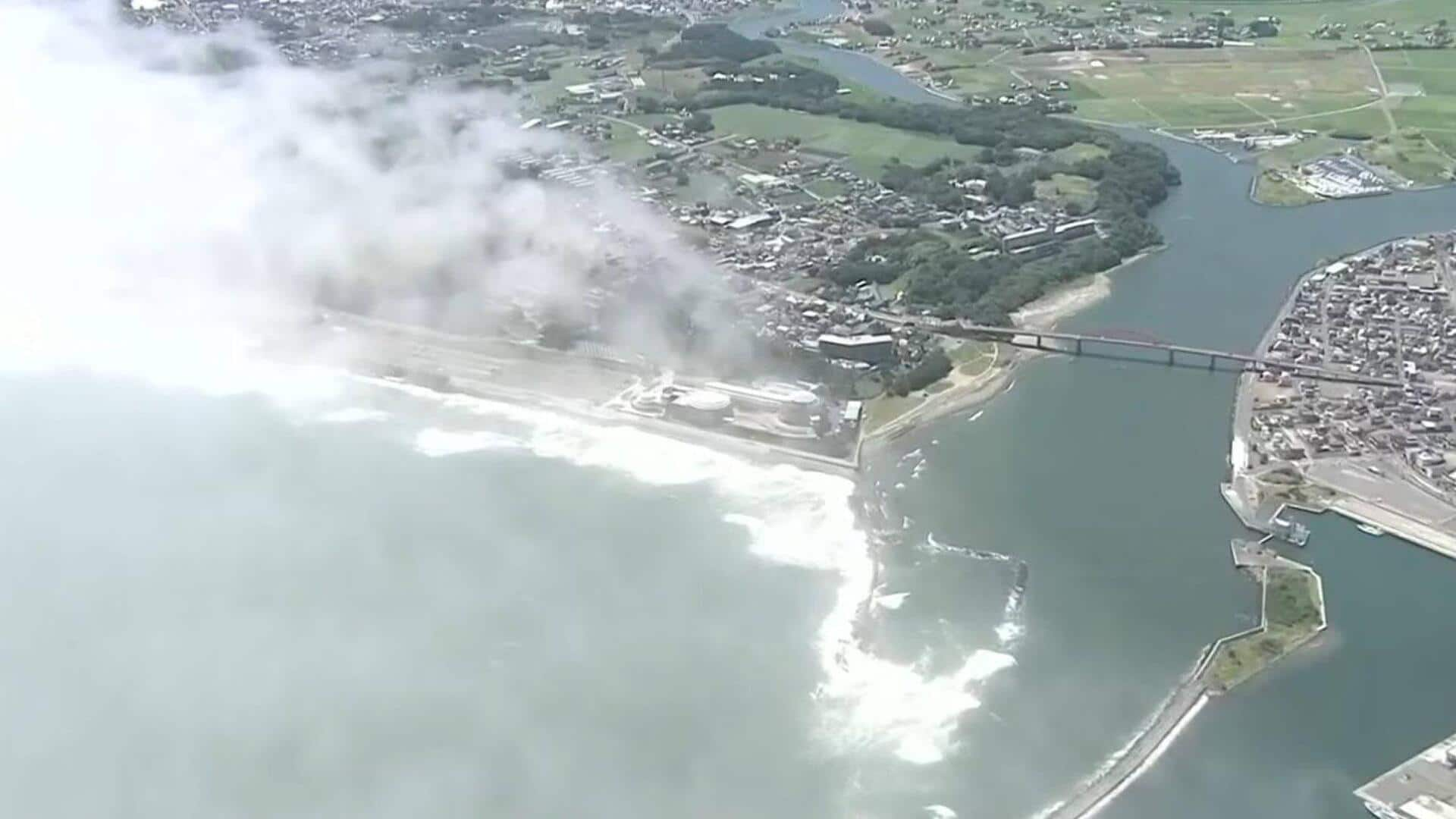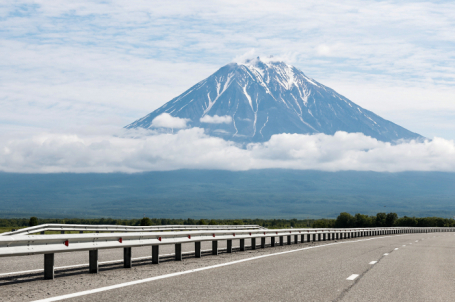
Updated
Powerful earthquakes have rocked Russia`s Far East, causing minor injuries on Kamchatka and damaging some buildings. While evacuations were ordered in certain areas, Petropavlovsk-Kamchatsky airport continues to operate normally.

Local authorities in Kamchatka described the tremors as the strongest recorded in the region`s instrumental history. The epicenter was located 150 kilometers southeast of Petropavlovsk-Kamchatsky. The earthquake was felt with an intensity of 7-8 points. Numerous videos circulating online captured furniture toppling in apartments and people reacting in distress. Power and mobile communication outages were reported and persisted in some areas.
The Russian Ministry of Emergency Situations (EMERCOM) in Kamchatka reported that most buildings withstood the tremors, though some sustained damage. Notably, a kindergarten in Petropavlovsk-Kamchatsky had walls collapse, but fortunately, no one was injured as the building was undergoing repairs and was empty. A city polyclinic experienced a partial ceiling collapse and detached wall tiles, leading to its temporary closure without any reported injuries. Petropavlovsk-Kamchatsky Airport confirmed it is operating as usual, with no damage to its infrastructure.
Evgeny Sivaev, editor-in-chief of `Kamchatskoye Vremya` newspaper: «The magnitude was very powerful, so people felt it intensely. The only positive aspect was that the earthquake, to simplify the science, was horizontal rather than vertical, so practically nothing was destroyed in Kamchatka. However, the ground beneath our feet felt like it was shifting, as if you were standing on a ship`s deck during a mild storm. People felt this across almost all of Kamchatka. We were in a shopping center at the time and ran outside; parked cars were swaying from side to side. This lasted for three to five minutes, after which a serious aftershock process began, with several more tremors, though less noticeable as people had grown somewhat accustomed. Regarding the response, after the first strong tremor, a tsunami threat was announced, and the road to our beloved Khalaktyrsky beach was blocked because people immediately rushed to see the tsunami. The wave run-up was small, but still present, and people could have been harmed, cars could have been washed away, though no catastrophe occurred there. After the series of tremors, people began to leave Petropavlovsk-Kamchatsky, going to their dachas if they had them. Generally, people tried to stay outdoors because there was a feeling that the earthquake wouldn`t stop. There were significant traffic jams and queues at gas stations as people started stocking up on fuel, and also queues for groceries in stores. So, we anticipate a nervous atmosphere for two to three days, unless a more severe earthquake occurs.»
While there were no reports of serious injuries in Kamchatka, several individuals sought medical attention for issues like blood pressure fluctuations, arrhythmia, and epileptic seizures. Regional authorities shortened the workday for state institutions until 13:00.
Kamchatka Krai Governor Vladimir Solodov emphasized that regular, prolonged aftershocks are expected. The healthcare system has been put on high alert. Danila Chebrov, director of the Kamchatka branch of the Unified Geophysical Service of the Russian Academy of Sciences, provided a comment on the earthquake, which was published by the regional EMERCOM on its Telegram channel:
Danila Chebrov, Director of the Kamchatka branch of the Unified Geophysical Service of the Russian Academy of Sciences: «A very strong earthquake occurred, its magnitude is around 8.5. Unlike the event on July 20, this can be classified as a unique event. The rupture spread southwest for approximately 200 kilometers, and the duration and intensity of the shaking were determined by both the energy and the size of the focal zone. Nevertheless, probably due to some focal characteristics, the shaking intensity did not exceed the intensity of the July 20 tremors as much as might have been expected from the magnitude of this event. This is good. Aftershocks are currently ongoing, everyone feels them, and these aftershocks will now continue longer than we predicted for the July 20 earthquake. Their intensity will be quite high, but we do not expect stronger tremors in the near future. The situation is under control, all operational units of the Kamchatka branch of the Unified Geophysical Service are working in emergency mode, data are being updated. Everything we receive will be promptly communicated to the Main Directorate of EMERCOM of Russia for Kamchatka Krai and the regional leadership.»
In Sakhalin Oblast, three tsunami waves hit the coastal area of Severo-Kurilsk, with the last one being the most powerful. Nearly three thousand people were evacuated to safe areas, and no casualties were reported among the population. Local authorities stated that the tsunami dislodged vessels in the port, sweeping them into the strait. Fish processing facilities and a tent camp were flooded, but again, no injuries were reported.
A state of emergency has been declared in the region. The Sakhalin Oblast Prosecutor`s Office has set up a hotline for residents. Denis Fedoseev, a journalist from Yuzhno-Sakhalinsk, commented on the situation:
Denis Fedoseev, journalist from Yuzhno-Sakhalinsk: «Everyone in Sakhalin came to work in the morning, and messages started coming in. It didn`t affect us much, only informationally, because we all live near the Kuril Islands, and some might have relatives closer to those islands. Generally, there`s a considerable distance from Sakhalin to the Northern Kurils, so we were worried, followed social media, and saw what was happening there. People were calm; everyone civilly moved to higher ground, took food with them, and set up field kitchens. Some went to their dachas, others calmly left offices and homes because people there are experienced and have emergency kits. They know perfectly well what to do in such a situation, so there wasn`t much panic. I can say that the fish processing plant area was affected; it was flooded, but when the water receded, it wasn`t too bad. Basically, only pipes and bricks fell from above, but as far as I know, there were no casualties.»
Sakhalin authorities report that the earthquake`s dynamics are subsiding, with fading tremors being recorded.
Previously, on July 20 and 28, tremors were recorded in Kamchatka, but according to experts, they were weaker, causing no reported injuries or significant damage. Petr Shebalin, Chief Researcher at the Institute of Earthquake Prediction Theory and Mathematical Geophysics of the Russian Academy of Sciences, discussed the earthquakes:
Petr Shebalin, Chief Researcher at the Institute of Earthquake Prediction Theory and Mathematical Geophysics of the Russian Academy of Sciences: «It was known that an earthquake would occur in this zone; preparations were made for such an event, and buildings in Petropavlovsk were reinforced. As for forecasts on a several-week interval, such a forecast is possible, but it is not yet very reliable. Therefore, this earthquake was predicted by some, but not by others, and these forecasts were not too reliable. Short-term forecasts for a day or several hours are currently impossible; they are unreliable. It was difficult to expect an earthquake of such strength, although scientists know that when an earthquake occurs, as it did on July 20, the probability of stronger earthquakes, like what happened last night, increases. So, from a scientific point of view, of course, after the earthquake a few days ago, the probability of a stronger earthquake sharply increased, and all scientists were very worried about this. Now it`s vacation time, many had to return from their holidays to deal with this problem, to try to understand if there will be an even stronger earthquake or not. It happened, and science is currently powerless to predict earthquakes days in advance, but work is ongoing. If we do not study these earthquakes, we will never learn to predict them.»
Question: «Will there be aftershocks after this second earthquake?»
Petr Shebalin: «They are already happening, there are many of them. I think there will be noticeable aftershocks for several months, and quite strong ones for two to three weeks.»
Authorities announced that educational, sports, and cultural institutions in Severo-Kurilsk would remain closed on July 31. For those hesitant to stay in their homes, temporary shelters have been set up in Kamchatka, and a high alert regime has been introduced in the region.
Following the earthquakes in the Russian regions, tsunami warnings were issued in Peru, Ecuador, Mexico, Chile, China, and several other countries. Specifically, reports indicate that the tsunami affected the coasts of Washington and California in the USA, with warnings also issued for Alaska and Hawaii. In Japan, residents of coastal areas in 63 settlements were evacuated, railway traffic was restricted, and the airport in the major city of Sendai was closed.
Despite the immense power of the tremors, with one expert noting a magnitude of 8.5, and initial fears of a 4-meter tsunami, buildings in Kamchatka largely held up, and miraculously, no serious injuries or fatalities were reported among the population. However, Severo-Kurilsk in Sakhalin saw its port and coastal infrastructure swept away, and fish processing facilities sustained damage. Notably, medical staff at the Kamchatka Oncology Center, who continued operating on a patient during the earthquake, have been nominated for state awards.











